Gustav Klimt (Vienna, 1862 - 1918) was the founder and one of the greatest exponents of the Viennese Secession(Wiener Secession), an association of nineteen people, including architects and artists of various kinds, who embarked on an automaton path, free from the Viennese academic thinking of the 1930s (the Secession was officially founded in Vienna in 1907). The movement’s goal was to rework a total work of art(Gesammtkunstwerk) that would combine architecture, sculpture, painting and design-a new artistic expression that could break free from tradition. Among the highest exponents, besides Klimt were Egon Schiele, Josef Hoffmann, Otto Wagner and Joseph Maria Olbrich.
The founding act of the group was the magazine Ver Sacrum (“Sacred Spring”), first published in 1898: founded by Klimt himself and Max Kurzweil, it was the official organ of the Viennese secession. Despite a lifespan of only five years(Ver Sacrum in fact ended publication in 1903), it had a major impact in the art world, redefining new styles for editorial graphics and typesetting, and was instrumental in the later development of Art Nouveau and Jugendstil.
Klimt was among the greatest animators of the cultural scene of his time, and his art dealt with a wide variety of themes: figures, allegorical subjects, landscapes, female nudes, religious themes, and portraits. In addition, Klimt was also a decorator, draughtsman, mosaicist, ceramist, lithographer. He was an extremely versatile artist and today extremely appreciated by the public, which continues to be fascinated by his rich and precious works, devoted to decorativism, pervaded by typical fin-de-siècle tensions, indebted to art history, from the Byzantine mosaics of Ravenna (which Klimt saw in person and appreciated) to the art of ancient Greece, from Dürer’s engravings to Japanese art.
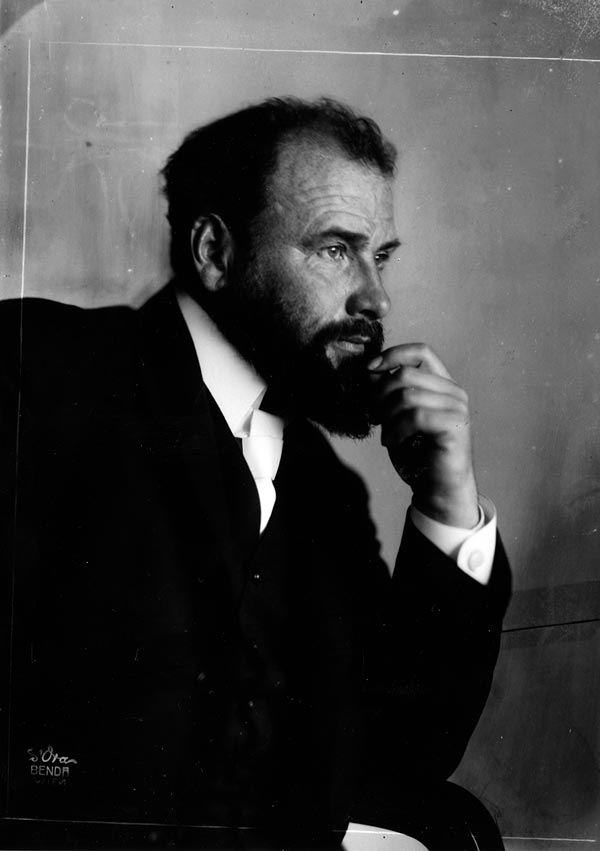 |
| Gustav Klimt |
Gustav Klimt was born on July 14, 1862, in Baumgarten, now a suburb of Vienna. From an early age he was passionate about art along with his siblings. Despite his family’s economic problems he still managed to attend the School of Arts and Crafts of Austria, where he enrolled in 1876 when he was only 14 years old, after finishing his studies at elementary school. During his academic studies, which lasted until 1883, he experimented with various artistic techniques, including ceramics and mosaic. Gifted with particular talent from a very young age, during his formative years he was considered and recognized as the greatest continuer of the work of Hans Makart, one of the most important Austrian artists of the time.
As the years passed, the great painter gave more and more evidence of his skill, and commissions were not slow in coming. In 1880 he joined an artists’ company called the Künstlerhaus, and in the same year he painted the four allegories of the Sturany Palace in Vienna and the ceiling of the Kurhaus in Karlsbad. In 1883, having finished his academic studies, he founded a working group with Franz Matsch and his brother Ernst, also a decorator and carver. The three collaborated for years, working on decorations including the ceiling of the two grand staircases of the world-famous Burgtheater. Inside the famous theater they tried their hand at decorating a series of panels depicting both ancient and contemporary scenes. Thanks to numerous commissions, the new creative partnership found particular success and admiration from both the public and patrons. This notoriety also led them to financial fulfillment, which allowed them to move into high society. The skill of Gustav Klimt, the most talented of the three, was widely recognized, and in 1888 he was awarded the Gold Cross for artistic merit by Emperor Franz Joseph I.
In 1892, due to the death of his brother Ernst a few months later than their father’s death, the company dissolved and Klimt thus decided to continue his artistic production alone. It was during this not easy year that he had the good fortune to meet Emilie Flöge, his life partner. The years that followed were very difficult for the painter, both because of the bereavements of his brother and father, to whom he was very close, and because of professional and artistic problems that led him to revolutionize his style, abandoning and repudiating the academic style with which he had painted up to that time. In 1897, he thus decided to found with nineteen other comrades the Wiener Sezession, a group of controversial and countercultural artists whose common goal was to break free from contemporary Viennese academic conformity and aim toward atotal art where art, architecture and design joined together merging into a single entity, a theme also common to other groups formed in Europe during those years such as William Morris ’ Arts&Crafts group and the various nascent new avant-gardes such as the Jugendstil in Germany orArt Nouveau in France. Although Klimt had espoused the classical style for years, at a certain point in his career he no longer reflected himself in his works and thus decided to free himself from the academic constraint imposed by the university where he studied for years.
Although today the ceiling decorations of the University of Vienna represent one of the master’s absolute masterpieces (despite their destruction following a fire in 1945 at Immendorf Castle), there were many confrontations and criticisms he received. In 1894 he was commissioned together with Franz Matsch (his former partner) to create a series of ceiling decorations for the Great Hall in which the proposed theme was “The Victory of Light over Darkness,” the works were to be created for the Faculty of Philosophy, Law and Medicine. Klimt was bitterly attacked even before he finished his works: the female representations were considered to have excessively sensual characters and anti-Classicist aesthetics. Many professors and patrons of the university avidly opposed the decorations so much so that they petitioned the Ministry of Education, demanding that the work be stopped. Wilhelm von Hartel, then Minister of Education, rejected the petition several times, and Klimt was allowed to continue his work. Later the artist declared, “I have had enough of censorship, now I do my own thing. I wish to get rid of it. I wish to free myself from all this nonsense that hinders me and prevents me from working.” Klimt and his secessionist comrades, despite the unfortunate affair at the university, managed to find notoriety and approval from wealthy bourgeois families, lovers of the new Avant-Garde they founded, as the years went by.
Thanks to a trip to Italy, particularly Ravenna, in 1903, the famous artist had the opportunity to get in touch with and see live the city’s important Byzantine mosaics. From this trip he drew many inspirations for later works, which were in fact characterized by the use of gold and opulence: these paintings would define the artist’s “golden” or “gilded” period . Works resulting from this period represent to this day important works by the master, we find for example: The Kiss (1907-08), Judith I (1901), The Tree of Life(1905-1909). With the second version of Judith in 1909, Klimt abandoned the Golden Age, and having passed the latter the artist came into conflict with the movement he himself founded, later deciding to leave the group due to differences of views and to approach the Viennese Laboratories where he left definitively the delicacy and gracefulness of the Secessionist lines by moving to a more pronounced and rough line, to a more flamboyant use of color, for which he also drew cues from the new avant-gardes present on the contemporary scene, such as the Impressionists or the Expressionists. The works that were the fruit of the new period, such as, for example, The Three Ages of Woman (1905) enabled him to participate in and win, in 1911, the prize at the International Art Exhibition in Rome, once again winning critical praise. A few years later, in 1918, following a pneumonia and stroke caused by the Spanish flu, the painter died, on January 11, leaving numerous paintings unfinished.
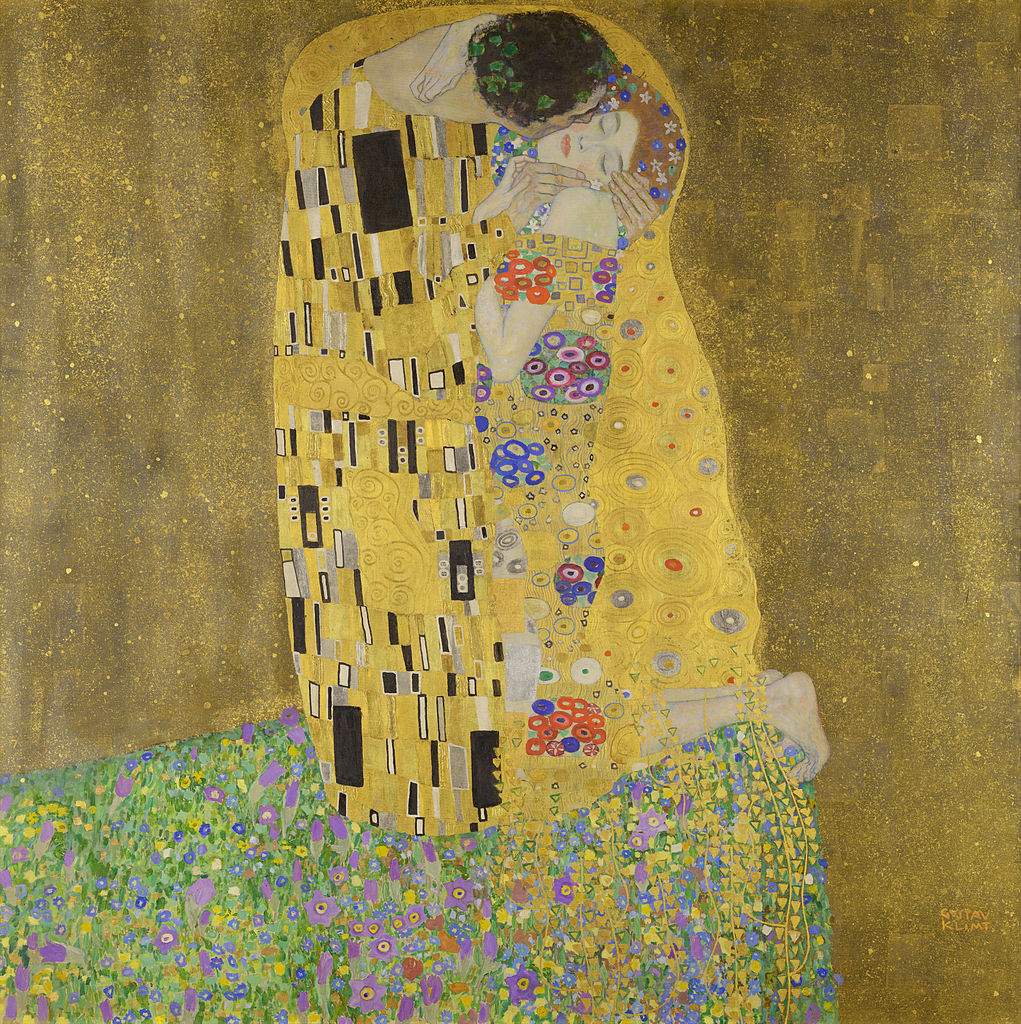 |
| Gustav Klimt, The Kiss (1907-1908; oil on canvas, 180 x 180 cm; Vienna, �?sterreichische Galerie Belvedere) |
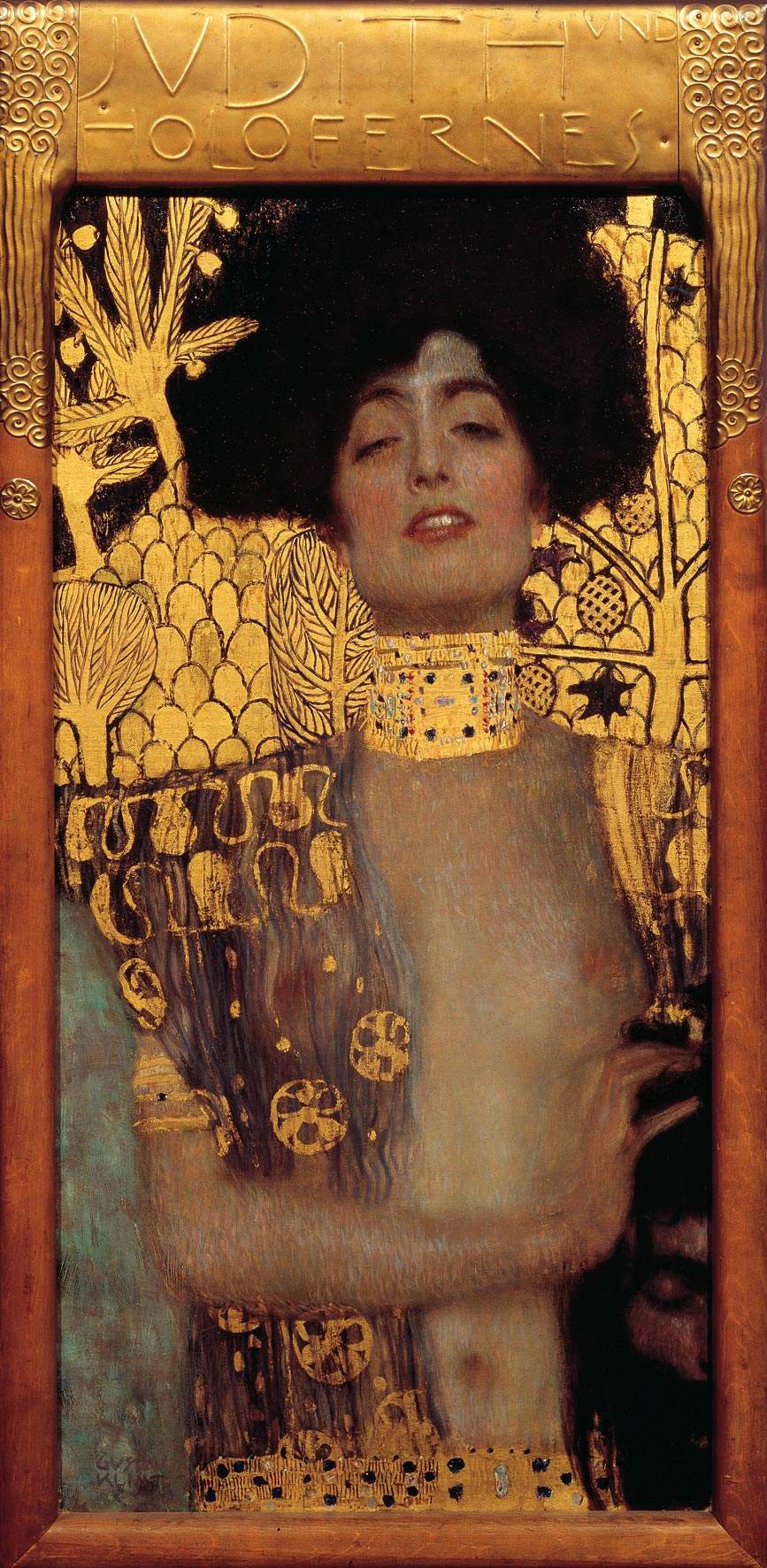 |
| Gustav Klimt, Judith I (1901; oil on canvas, 84 x 42 cm; Vienna, �?sterreichische Galerie Belvedere) |
In the course of his artistic activity, Gustav Klimt experimented with various artistic techniques. During his training at the Academy, he began to deal with ceramics and mosaics, maintaining a purely academic painting style that also characterized his works after his studies. During the most difficult years of his career, just after the death of his father and brother, caught up in existential crises, he decided to abandon the academic style, opting for a countercultural avant-garde style that resulted in the founding of the Wiener Sezession.
After 1903, thanks to a trip to Italy that influenced his way of making art, he began to create a series of works with golden mosaic inserts reminiscent of the Byzantine ones in the city of Ravenna. Symbolic paintings of this period would be The Kiss (1907-08), Judith I (1901) and Judith II (1909:the latter decreed the end of the Golden Age. Later, influenced by the new rising avant-gardes such as Expressionism and Impressionism Klimt decided to question his art once again by experimenting with a style of painting that was new to him, consisting of a rough and unpolished painting style with less precise strokes and more vivid colors (an example of this is the Portrait of a Lady in the Ricci Oddi Gallery in Piacenza). Despite various experiments, Klimt was always able to demonstrate his greatness and versatility in the artistic field by always placing his great talent at the center of attention.
Among the recurring themes of the famous master is his special attention to the female world. There are numerous depictions of female figures that exude sensuality and lust; the femme fatales he depicts are lustrous, gold-enriched women with an uncanny gaze that intimidates and leaves one dazzled. Woman in Klimt is the protagonist and depicts the emblem of femininity. His greatest interest in this world culminates in the creation of works such as Judith I (1901) and Judith II (1909) .
In Judith I, Klimt uses as usual to do a typically Symbolist and decorative language, also inserting with gold that gives the work even more glitz and lust. The figure depicted is a cruel and powerful woman holding in her arms the head of Holofernes, her beloved. The latter’s head is depicted only in foreshortening while the figure of the femme fatale dominates the scene, emphasizing her majesty and imposition. In Judith II, the figure is represented in full height, accentuating even more, compared to the first version, the verticality of the painting. The woman’s face this time is depicted almost in profile, here the woman is naked and uncovering her breasts that emerge from her decorated robes. The model from whom he took inspiration to paint these two versions was Adele Bloch-Bauer, the painter’s favorite muse. Their working and perhaps emotional relationship began when Adele’s husband commissioned the painter to paint a portrait of his beloved. From that moment she became the master’s muse, becoming the protagonist of many famous works including The Kiss, one of the most important and well-known works in all of art history. It is a painting belonging to the Golden Age and depicts two young lovers in the act of an embrace (in fact, it can be seen that the woman lets herself fall into the arms of her beloved who holds and kisses her). Both figures are wrapped in golden drapes and intensely decorated with mosaics. In addition to the theme of female representation in this painting is another recurring theme in the artist’s painting, love, characteristic of works such as theEmbrace (1905-1909)or the Beethoven Frieze (1902). The work exudes gentleness and serenity, and the atmosphere is also emphasized by the completely golden background except on the ground, where in a flowery patch of earth the two lovers hold each other.
Also among the most important works of the mature Klimt is The Three Ages of Woman from 1905(read an in-depth discussion of the painting here). This painting is part of the most mature works in Klimt’s artistic activity, in which there is a move away from the use of gold toward less showy and more immediate painting. The painting depicts, as he was wont to do, three women representing three different periods of female life. We find there depicted first of all childhood, through the representation of a small girl in the arms of another woman who also represents another phase, that of motherhood, in which a female figure with long, curly hair sprinkled with flowers is depicted. Another woman is seen by her side: symbolizing old age, the last stage of life. The woman here is painted with her face hidden by her long gray hair and her naked body in all its entirety and imperfection. The three figures are extremely close together and occupy the central part of the painting. The dark background, which occupies most of the space, is given by a combination of colors such as ochre or brown. The darkness of the background tends to make the three figures stand out by enhancing the passage of time and their beauty.
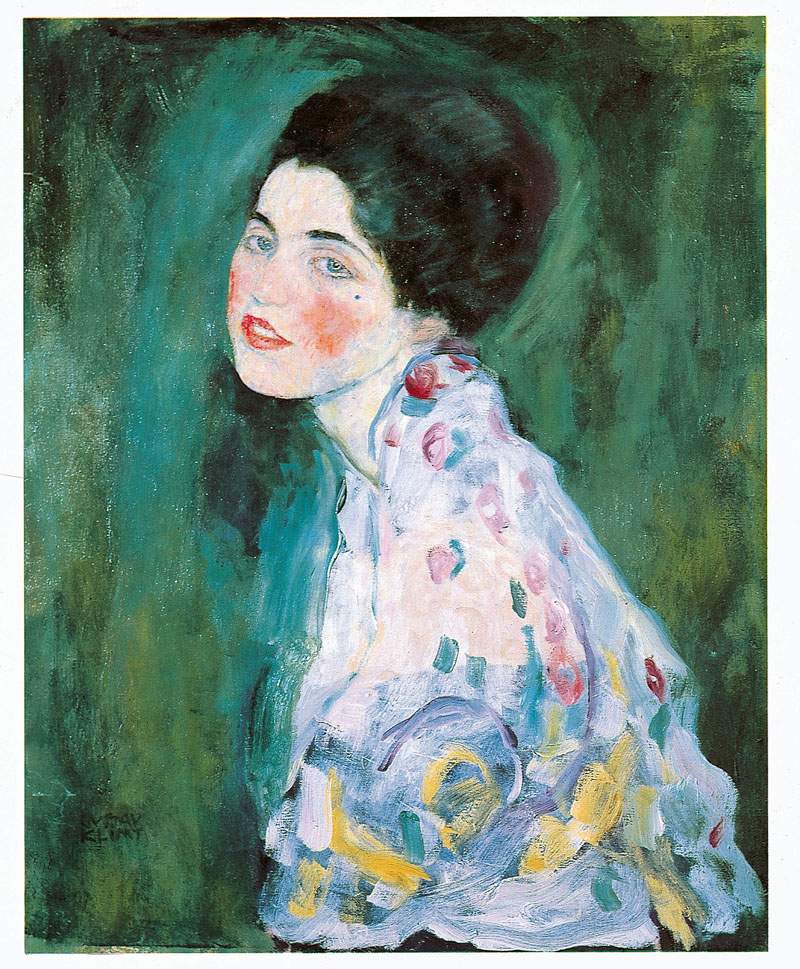 |
| Gustav Klimt, Portrait of a Lady (1916-1918; oil on canvas, 68 x 55 cm; Piacenza, Ricci Oddi Gallery) |
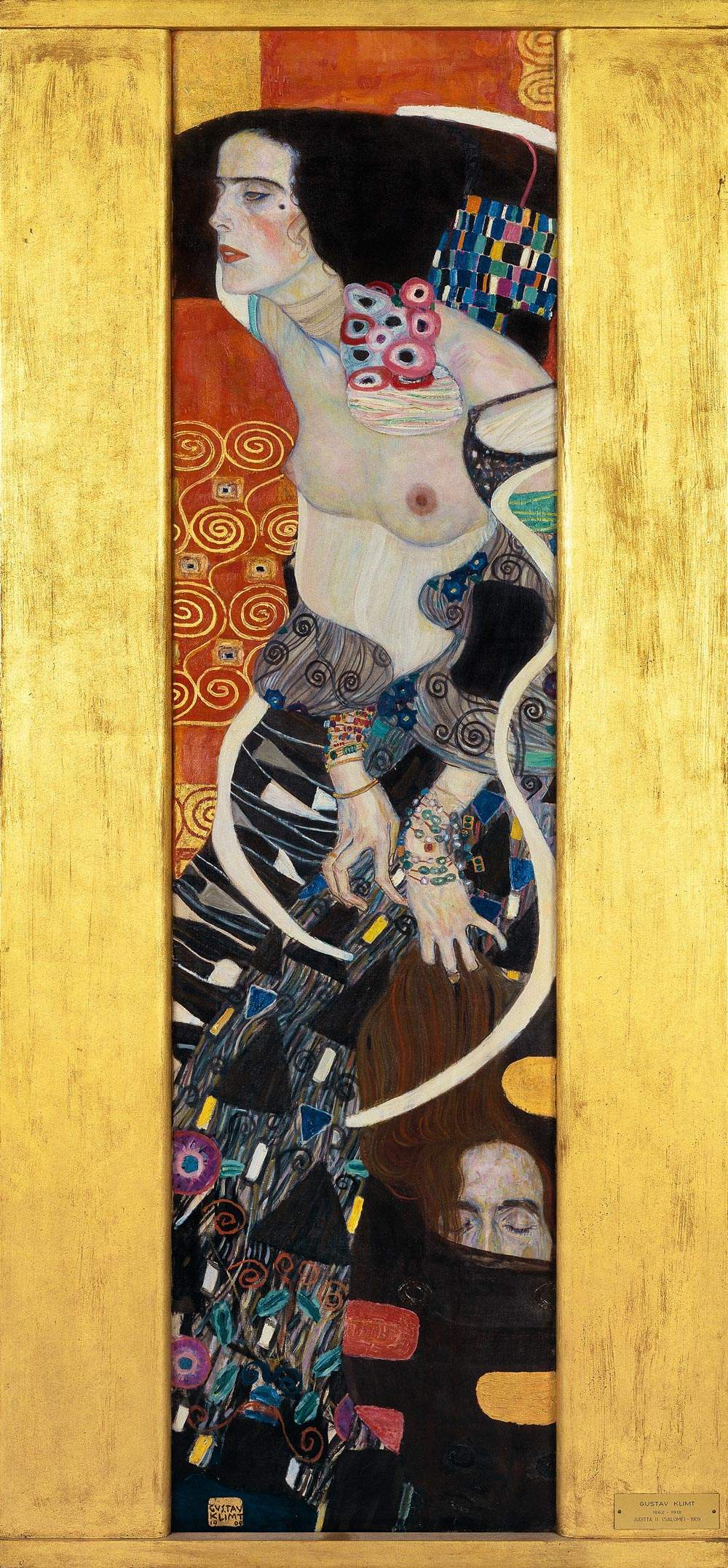 |
| Gustav Klimt, Judith II (1909; oil on canvas, 178 x 46 cm; Venice, Galleria Internazionale dArte Moderna di Ca Pesaro) |
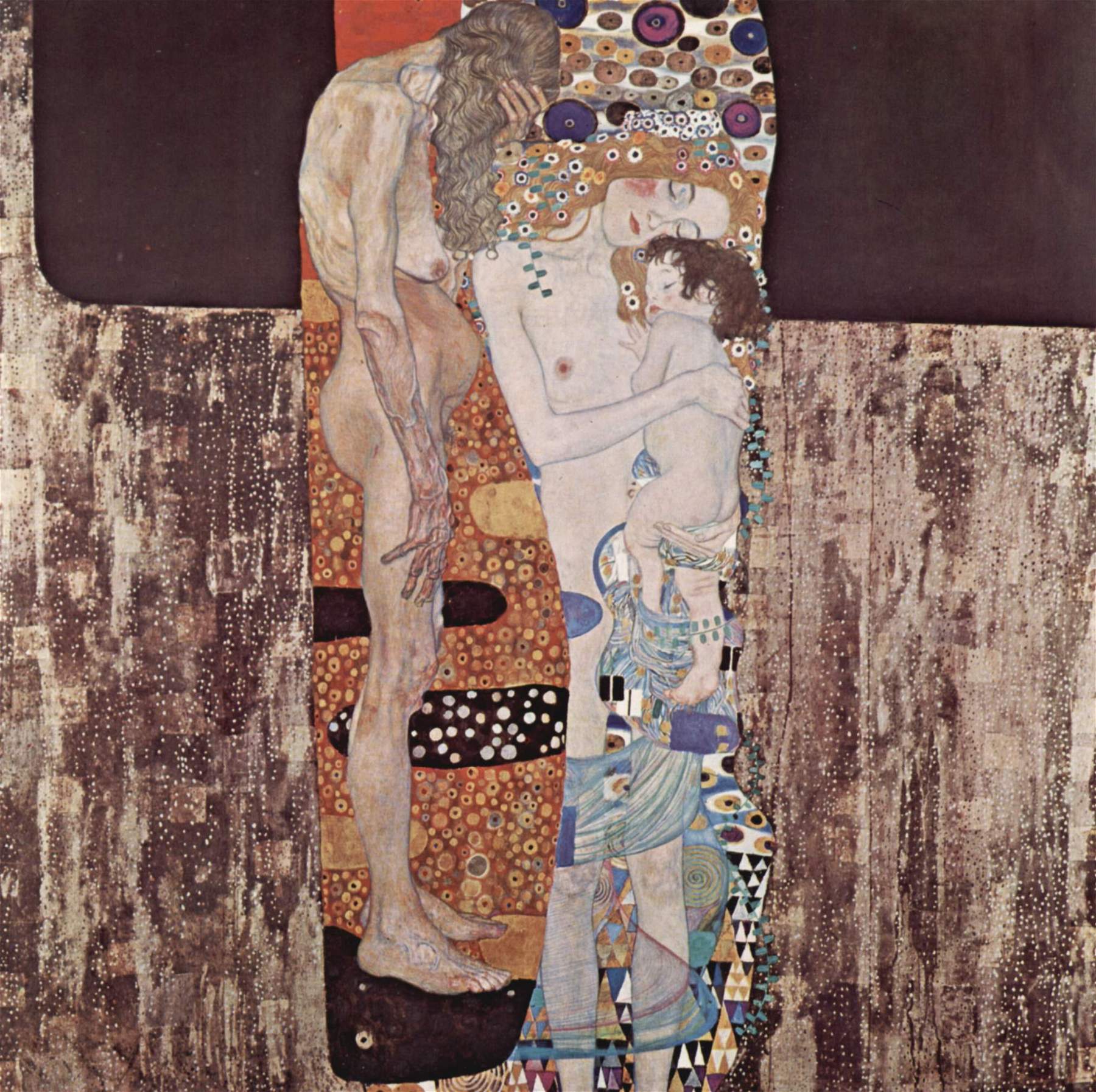 |
| Gustav Klimt, The Three Ages of Woman (1905; oil on canvas, 180 x 180 cm; Rome, Galleria Nazionale dArte Moderna e Contemporanea) |
Gustav Klimt’s major works are exhibited mainly in museums in his hometown of Vienna. The ideal place to see the works of Klimt and all the Secessionists is definitely the Secession Palace, which is still the symbolic home of Viennese Secessionism. It was built between 1897 and 1898 to a design by Joseph Maria Olbrich, who took inspiration from a drawing by Klimt depicting a cubic temple-like palace.
Other places to view the works include the Burgtheather where Klimt worked together with Franz Matsch and his brother Ernst shortly before his death, the Galerie Belvedere (where the Kiss and Judith I are located), the Museum of the History ofArt(Kunsthistorisches Museum) where Klimt together with his two associates painted about 40 spandrels and intercolumniums, and the MAK - Museum of Applied Arts in Vienna where it is possible to see live the nine preparatory drawings made between 1905 and 1909 for the Stoclet Frieze.
In Italy there are three museums that house as many works: the Galleria Nazionale d’Arte Moderna e Contemporanea in Rome preserves the painting The ThreeAges ofWoman (1905), which Klimt painted in his last period and with which he won the prize at the Rome International Art Exhibition in 1911.
In Venice, on the other hand, at the International Gallery of Modern Art at Ca’ Pesaro it is possible to see Judith II, a very famous and highly regarded painting by the artist, which he made in 1909 shortly before leaving his golden age. The last Italian painting is the Ritratto di signora (Portrait of a Lady ) at the Ricci Oddi Gallery in Piacenza, a work that was the protagonist of a sensational theft in 1997 and was rediscovered in 2019.
 |
| Gustav Klimt. Life and works of the founder of the Viennese Secession. |
Warning: the translation into English of the original Italian article was created using automatic tools. We undertake to review all articles, but we do not guarantee the total absence of inaccuracies in the translation due to the program. You can find the original by clicking on the ITA button. If you find any mistake,please contact us.